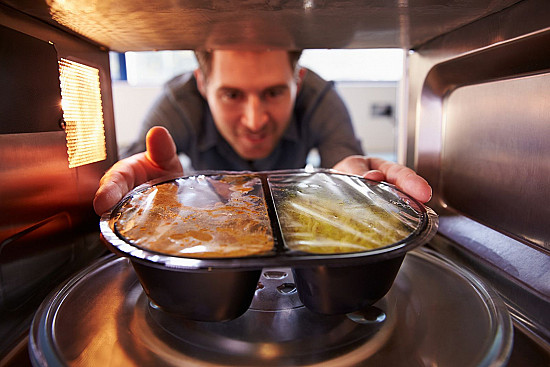Studies Show Microwaves Drastically Reduce Nutrients
Vegetables include sensitive compounds like amino acids, vitamins, and phytonutrients that are damaged more severely by microwaving than other forms of cooking. (Africa Studio/Shutterstock)
Did you know that microwaving your food is one of the most damaging things you can do to reduce food quality and nutrition?
I can remember the days growing up in the 1950s and 1960s, when we prepared foods without a microwave oven. Water was boiled on the stove. Chicken was baked in an oven. Vegetables were steamed, baked, or sautéed. Food was whole and fresh. Even a TV dinner was baked in the oven, which took about 15 minutes to warm.
And then, modern science and technology brought us the microwave oven that could heat food rapidly, from 30 seconds to a couple of minutes.
Story continues below advertisement
The industry has claimed that microwave cooking protects the nutrient content of foods. Somehow, in tasting foods that came out of a microwave oven, the texture was changed, as was the flavor. Foods cooked or reheated in microwave ovens became rubbery and lacked the savory smells and layered flavors that come from cooking foods slower and longer.
Nevertheless, people bought the convenience aspect: the speed and simplicity of heating and eating prepared foods. The science, which has been supported by the food industry, has continued to claim the health benefits of microwave cooking. Recently published data from reliable sources questions the health benefits of microwaved food.
Does this mean an occasional microwaved meal will be harmful? Not likely. But what about a steady diet of eating foods cooked at such a high heat? Do the sensitive compounds in food, such as amino acids, fatty acids, vitamins, and phytonutrients change? It appears so. Read on to follow the scientific literature surrounding the depletion of our soil, foods, and health as a result of modern farming, food processing, microwave cooking, and not eating enough fresh, natural, uncooked, organic whole foods.
- Three studies of historical food composition have shown 5 to 40 percent declines in some of the minerals in fresh produce, and another study found a similar decline in our protein sources.
- A 1999 Scandinavian study of the cooking of asparagus spears found that microwaving caused a reduction in vitamins.
- In a study of garlic, as little as 60 seconds of microwave heating was enough to inactivate its alliinase, garlic’s principal active ingredient against cancer.
- A study published in the November 2003 issue of The Journal of the Science of Food and Agriculture found that broccoli “zapped” in the microwave with a little water lost up to 97 percent of its beneficial antioxidants. By comparison, steamed broccoli lost 11 percent or fewer of its antioxidants. There were also reductions in phenolic compounds and glucosinolates, but mineral levels remained intact.
- A recent Australian study showed that microwaves cause a higher degree of “protein unfolding” than conventional heating.
- Microwaving can destroy the essential disease-fighting agents in breast milk that offer protection for your baby. In 1992, a Stanford University School of Medicine study found that microwaved breast milk lost lysozyme activity, antibodies, and fostered the growth of more potentially pathogenic bacteria.
The Stanford study found more damage was done to the milk by microwaving than by other methods of heating, concluding: “Microwaving appears to be contraindicated at high-temperatures, and questions regarding its safety exist even at low temperatures.”
Needless to say, we don’t recommend cooking food in microwave ovens, though mildly heating leftovers may not pose the same problems as discussed above.
In other cases, the problems outweigh the convenience. Microwaving fatty foods in plastic containers leads to the release of dioxins (known carcinogens) and other toxins into your food. Common microwavable foods include pizzas, chips, and popcorn. Chemicals released include polyethylene terephthalate, benzene, toluene, and xylene.
Additionally, microwaving creates new compounds that aren’t found in humans or in nature, called radiolytic compounds. We don’t yet know what these compounds are doing to your body, but they aren’t health-promoting.
Eating fresh, uncooked, or minimally heated fruits and vegetables, nuts and seeds, herbs and spices is the basis of my Eating for Health meal plan. With whole grains and legumes, cooking them on a stovetop by boiling and simmering them until tender is advised.
For flesh foods, steaming, sautéing, baking, or blending into slow-cooked crockpot soups and stews is advised. Dairy products, such as milk cheese, from goats, cows, or sheep, are most nutrient-rich when unheated. Raw, organic cheese is best added to salads or warm grains, legumes, or vegetables without heating the dish in a high-heat oven, broiler, or microwave oven.
For more information on microwave technology’s adverse effects on food and health consult the GreenMedinfo database on the subject: 28 Studies on the adverse effects caused by microwave cooking.
Edward Bauman holds a master’s in education and a doctorate in health promotion. Bauman is the founder and president of Bauman College Holistic Nutrition and Culinary Arts. After three decades of in-depth study of worldwide health and nutrition systems, Bauman created the ‘Eating for Health’ (E4H) nutrition system, which is the foundation of the Bauman College Nutrition and Natural Chef Training Programs. This article was originally published on GreenMedinfo.com
Check out our menu HERE!


